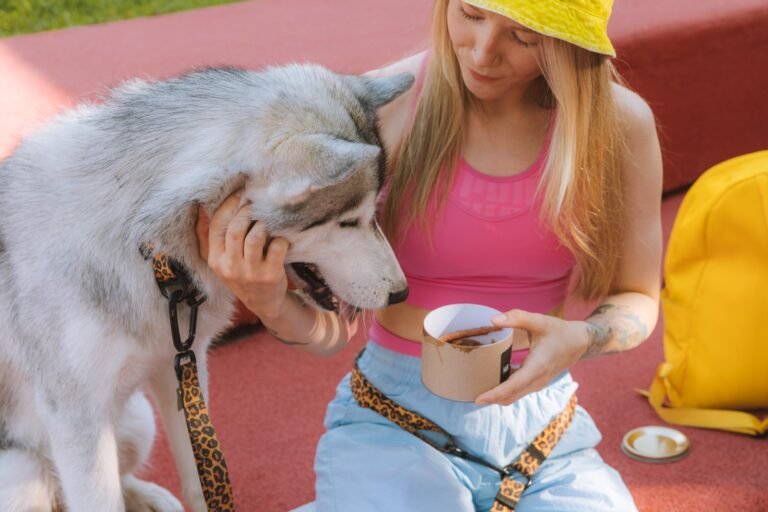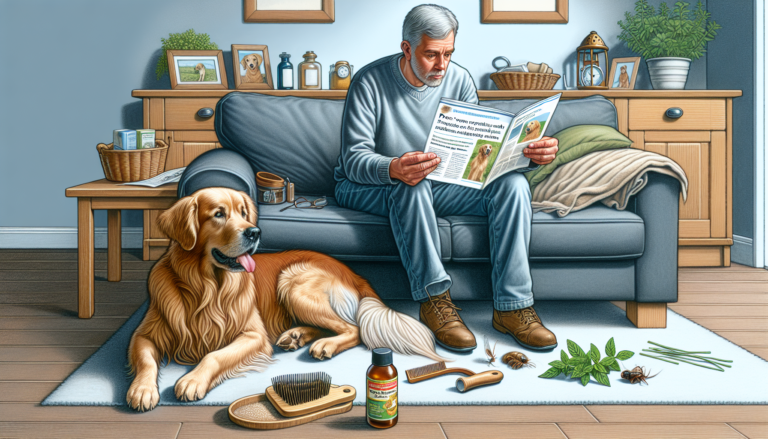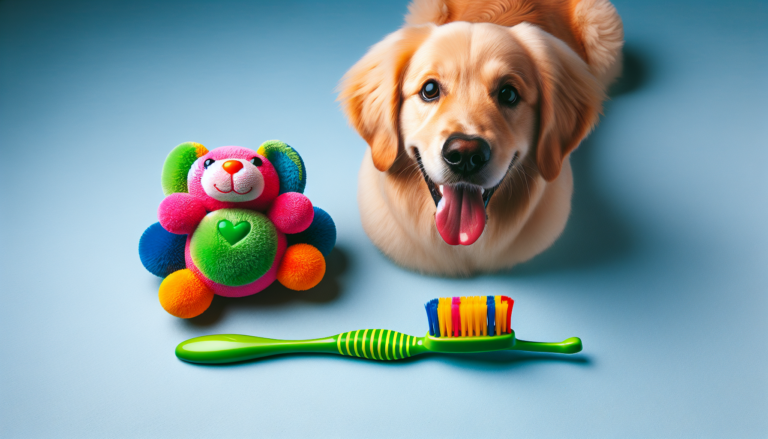Top Ways To Exercise Your Dog For Optimal Health
Want to keep your furry companion happy and healthy? Exercise is key! In this article, we’ll explore the top ways to exercise your dog for optimal health. From walks in the park to playful games, there are plenty of fun activities that will not only burn off excess energy but also provide mental stimulation. Whether you have a high-energy breed or a more laid-back pup, these exercise ideas will help keep your dog in top shape and ensure a strong bond between the two of you. So grab a leash and get ready for some tail-wagging adventures!
Indoor Exercise Ideas
Play fetch indoors
When the weather doesn’t permit outdoor activities, playing fetch indoors can be a great way to keep your dog active and entertained. Choose a soft indoor ball or a plush toy that you can safely throw without causing any damage. Find a space in your home where you can play without the risk of breaking any valuables. Clear any obstacles that may hinder your dog’s movement and enjoy a fun game of fetch together.
Set up obstacle courses
Transform your living room or backyard into an exciting obstacle course for your dog. Use household items like furniture, cushions, and boxes to create a challenging and stimulating environment. Set up tunnels made from blankets or use hula hoops as hurdles. Guide your dog through the course, rewarding them with treats and praise as they successfully tackle each obstacle. Not only will this provide physical exercise, but it will also engage your dog’s problem-solving skills.
Use interactive toys
Interactive toys are a fantastic way to provide mental stimulation and exercise for your dog. These toys often require the dog to think and work to obtain a reward, such as a treat hidden inside. Get a puzzle toy or treat dispenser that challenges your dog’s mind and keeps them occupied. This type of activity can be especially beneficial for dogs that are prone to boredom or excessive chewing.
Try indoor agility training
Agility training is not limited to outdoor spaces. Set up a mini agility course in your home or a spacious room, using items like tunnels, jumps, and weave poles specifically designed for indoor use. You can even make DIY obstacles using household objects. Agility training allows your dog to work on their coordination, balance, and speed. It also provides mental stimulation and helps to build confidence.
Engage in hide and seek games
Hide and seek is a playful and mentally stimulating game that dogs of all ages can enjoy. Start by teaching your dog the “stay” command and find a hiding place in your home. Once hidden, call out your dog’s name or use a designated cue word to let them know it’s time to find you. As your dog searches for you, reinforce their efforts with treats and praise. This game not only exercises your dog’s body but also challenges their sense of smell and problem-solving abilities.
Outdoor Exercise Ideas
Go for regular walks
Daily walks are essential for keeping your dog physically and mentally fit. A leisurely stroll around the block allows your dog to explore different scents, socialize with other dogs, and burn energy. Vary the routes to keep things interesting and consider using a harness or a gentle lead that reduces strain on your dog’s neck. Remember to bring waste bags to clean up after your dog and always use appropriate leashing techniques. Walking is a great exercise for all dogs, regardless of their age or breed.
Explore trails and hiking
If you have access to nature trails or hiking paths, take advantage of the opportunity to explore the great outdoors with your furry friend. Hiking provides a more challenging workout for both you and your dog. It offers varied terrain, fresh air, new sights, and smells. Check the rules of the trail before bringing your dog, and ensure they are up to date on vaccinations and protected against ticks and fleas. Remember to pack essentials like water, snacks, and a first aid kit.
Visit a dog park
Dog parks are wonderful places for your dog to socialize, exercise, and have fun with other dogs. These designated spaces allow off-leash play, giving your dog the freedom to run, chase, and interact with their peers. Dog parks usually have fenced areas, water stations, and waste disposal units. Before visiting a dog park, make sure your dog is properly vaccinated, spayed or neutered, and well-trained to ensure a positive experience for everyone involved.
Try bike or scooter rides
For active dogs, bike or scooter rides can be a thrilling way to burn off excess energy. Attach a special dog attachment or a bike trailer designed for dogs to your bike or scooter. Make sure the attachment is secure and comfortable for your dog. Start with short rides, gradually increasing the distance and speed as your dog becomes more accustomed to the activity. It’s important to be aware of your dog’s physical limitations and avoid overexertion.
Engage in water activities
If you and your dog enjoy the water, swimming, and water activities can be a fantastic way to exercise. Find a dog-friendly beach, lake, or pool where your dog can safely swim and play. Swimming is a low-impact exercise that is easy on the joints and great for dogs with arthritis or other mobility issues. Always provide supervision and consider using a canine life jacket if your dog is not a strong swimmer. After any water activity, make sure to dry your dog thoroughly to prevent them from getting cold or developing skin irritations.
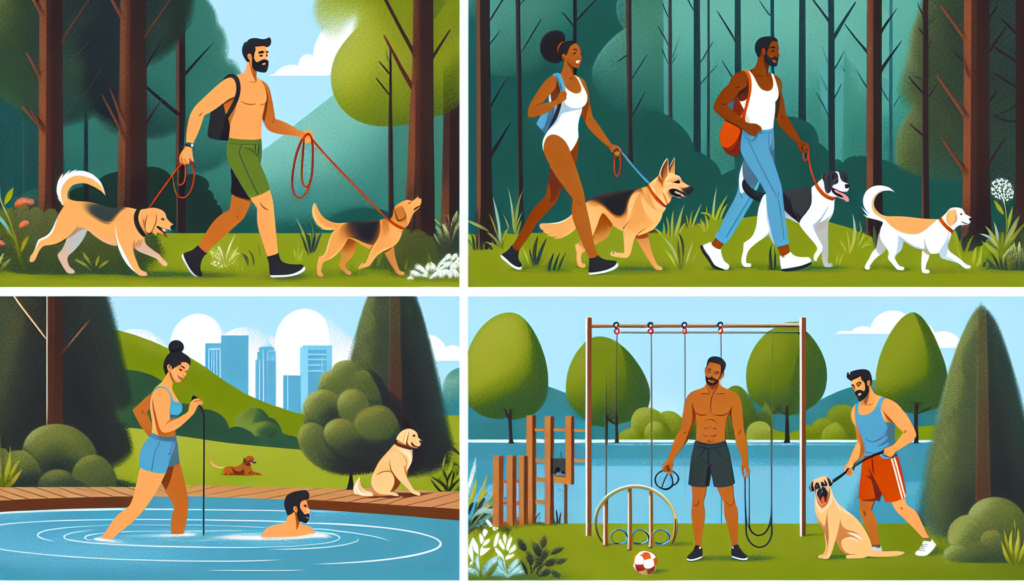
Activities for Mental Stimulation
Teach new tricks or commands
Keeping your dog mentally stimulated is just as important as providing physical exercise. Teaching your dog new tricks or commands is a fun and engaging way to challenge their brain. Start with simple commands like sit, stay, or lie down, and gradually progress to more complex tricks like shake hands or roll over. Use positive reinforcement techniques such as treats, praise, and clicker training to motivate your dog. Regular training sessions not only stimulate their mind but also strengthen the bond between you and your furry friend.
Practice obedience training
Obedience training is an essential aspect of having a well-behaved dog. It provides mental stimulation, establishes clear communication between you and your dog, and helps prevent behavioral problems. Focus on basic commands like sit, stay, come, and heel. Use positive reinforcement, consistency, and patience to reinforce good behavior. Obedience training can be done indoors or outdoors, and it’s important to create a distraction-free environment to maximize your dog’s focus and learning.
Use puzzle toys and treat dispensers
Puzzle toys and treat dispensers are excellent tools to engage your dog’s problem-solving skills and keep them mentally stimulated. These toys require your dog to figure out how to access a hidden treat or reward. Choose toys that are appropriate for your dog’s size and level of difficulty. Fill the toy with treats or kibble, and let your dog work to retrieve them. This type of activity not only provides mental exercise but also helps to alleviate boredom and prevent destructive chewing.
Engage in scent games
Dogs have a highly developed sense of smell, and engaging in scent games taps into their natural abilities. Hide treats or favorite toys around your home or in the backyard, allowing your dog to use their nose to locate the hidden items. You can also try scent work or nose work classes offered by professional trainers. These classes provide structured activities that challenge your dog’s scent detection skills and enhance their mental well-being.
Play brain games
Brain games are specifically designed to challenge your dog’s cognitive abilities and problem-solving skills. Examples include finding hidden treats under cups, guiding your dog through a maze, or solving a simple puzzle. These games can be easily created using household items or purchased from pet supply stores. Engaging in brain games not only exercises your dog’s mind but also enhances their ability to focus, learn, and adapt.
Intensity and Duration
Consider your dog’s breed and age
When determining the intensity and duration of exercise, it’s essential to consider your dog’s breed and age. Different breeds have varying exercise needs and tolerances. High-energy breeds like Border Collies or Australian Shepherds require more intense and longer exercise sessions compared to low-energy breeds like Bulldogs or Basset Hounds. Similarly, puppies and senior dogs have different energy levels and physical capabilities, requiring appropriate adjustments in exercise intensity and duration.
Gradually increase exercise intensity
Avoid sudden bursts of intense exercise, especially if your dog is not used to regular physical activity. Gradually increase the intensity and duration of exercise sessions over time. This allows your dog’s muscles, joints, and cardiovascular system to adjust and minimize the risk of injury or overexertion. Pay attention to your dog’s cues and be mindful of any signs of fatigue, such as excessive panting, reluctance to continue, or lameness.
Ensure appropriate duration for exercise
The duration of exercise sessions depends on your dog’s age, breed, and fitness level. As a general guideline, aim for at least 30 minutes to 1 hour of exercise per day for adult dogs. However, some high-energy breeds may require even more exercise. Puppies and senior dogs may need shorter and more frequent exercise sessions to avoid overexertion. It’s crucial to find a balance between meeting your dog’s exercise needs while respecting their physical limitations.
Monitor your dog’s energy levels
During exercise, closely observe your dog’s energy levels and behavior. If your dog seems excessively tired, shows signs of discomfort, or refuses to continue, it’s important to respect their limits and provide rest. Overexertion can lead to injuries or health issues. On the other hand, if your dog still seems full of energy even after exercise, it may be an indication that they need additional mental stimulation or physical activity.
Seek professional guidance when necessary
If you’re unsure about the appropriate exercise routine for your dog or have concerns about their health or fitness, don’t hesitate to seek professional guidance. Contact your veterinarian, a certified dog trainer, or a canine fitness specialist to discuss your dog’s specific needs. These professionals can provide tailored advice and exercise plans based on your dog’s individual characteristics and help ensure their optimal health and well-being.
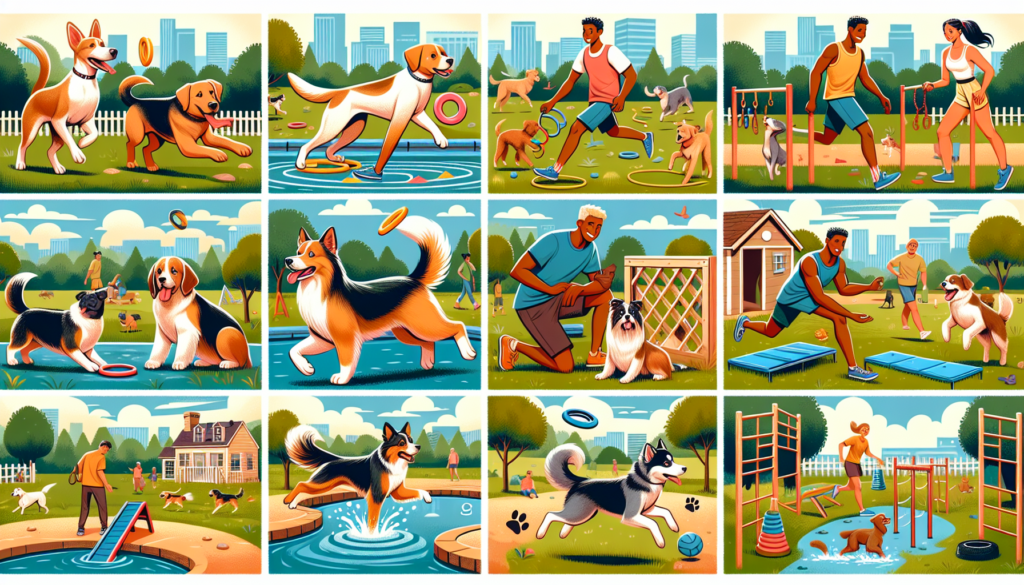
Safety Tips
Consult with your veterinarian
Before starting any new exercise routine, consult with your veterinarian to ensure your dog is in good health and physically capable of engaging in specific activities. They can assess your dog’s overall fitness, identify any underlying medical conditions, and offer guidance on the appropriate exercise plan. Additionally, your vet can provide recommendations on vaccinations, flea and tick prevention, and general safety precautions.
Warm up and cool down
Similar to humans, dogs benefit from warming up and cooling down before and after exercise. Prior to intense physical activity, take a few minutes to engage in light exercise or play to gradually increase your dog’s heart rate and loosen their muscles. After the exercise session, allow for a gentle cool-down period, which can include walking at a slower pace or gentle stretching. This helps prevent muscle soreness and reduces the risk of injury.
Provide plenty of water
Hydration is crucial during exercise, especially on hot days or during intense activities. Always bring plenty of water for both you and your dog when venturing outdoors. Offer frequent water breaks to prevent dehydration and overheating. Invest in a portable water bottle or collapsible bowl that can easily be carried and used to provide fresh water for your dog. Remember to refill the container regularly to ensure continuous access to water.
Avoid exercising in extreme weather
Extreme weather conditions, such as excessive heat, extreme cold, or heavy rain, can pose risks to your dog’s health and safety. Avoid exercising your dog during the hottest or coldest parts of the day and limit exposure to extreme weather conditions. If it’s too hot, consider early morning or late evening walks, or find an indoor space for exercise. In the winter, protect your dog from freezing temperatures by outfitting them with appropriate clothing and limiting exposure to icy or slippery surfaces.
Watch out for hazards and potential dangers
When participating in outdoor activities, be vigilant and aware of potential hazards or dangers. Watch out for sharp objects, broken glass, or toxic plants that your dog could come into contact with. Keep your dog on a leash when necessary to prevent them from running into traffic or getting lost. Be cautious around bodies of water to avoid accidents or drowning. By being proactive and attentive, you can create a safe environment for your dog to exercise and play.
Benefits of Exercise
Maintains healthy weight
Regular exercise is essential for maintaining a healthy weight in dogs. Just like in humans, obesity in dogs can lead to a variety of health issues, including joint problems, diabetes, and heart disease. Exercise helps burn calories, build muscle mass, and prevent excessive weight gain. It also boosts metabolism, keeping your dog’s body in optimal condition.
Promotes cardiovascular health
Engaging in aerobic exercises, such as walking, running, or swimming, promotes cardiovascular health in dogs. These exercises strengthen the heart muscle, improve circulation, and increase lung capacity. A healthy cardiovascular system ensures that oxygen and nutrients are delivered efficiently throughout the body, improving overall health and well-being.
Builds strong muscles and bones
Exercise plays a crucial role in building and maintaining strong muscles and bones in dogs. Activities like running, jumping, and agility training put stress on the muscles and bones, stimulating their growth and strengthening. Strong muscles and bones contribute to proper body alignment, stability, and mobility.
Enhances mental well-being
The mental well-being of dogs is greatly influenced by regular exercise. Physical activity releases endorphins, popularly known as the “feel-good” hormones. These hormones help reduce stress, anxiety, and depression in dogs. Exercise also provides mental stimulation, which is crucial for preventing boredom and behavioral issues. When your dog is mentally stimulated and content, they are more likely to exhibit good behavior and have a positive outlook on life.
Reduces behavioral issues
Regular exercise is a key component in managing and preventing behavioral problems in dogs. Dogs that are not sufficiently exercised can become bored, frustrated, and exhibit destructive behaviors such as chewing, digging, or excessive barking. Engaging in physical activities helps channel their energy in a positive way, preventing the development of behavioral issues. Additionally, exercise provides an outlet for playful and social behaviors, reducing the likelihood of aggression or other negative behaviors.
Socialize While Exercising
Arrange playdates with other dogs
Exercising with other dogs is a fantastic opportunity for socialization. Arrange playdates with friends, family, or neighbors who have friendly and compatible dogs. Let them play together off-leash in a secure area or embark on a group walk. Socializing with other dogs helps your dog learn appropriate social skills, improves their behavior around other animals, and provides an opportunity for joyful interactions.
Participate in group training classes
Enrolling your dog in group training classes not only provides essential obedience training but also allows for socialization with other dogs and people. Group classes provide a controlled and supervised environment where your dog can learn to focus and obey commands amidst distractions. It also provides an opportunity for your dog to interact and learn from other dogs’ behavior. Train together, have fun, and build new friendships.
Join dog-friendly events or competitions
Dog-friendly events and competitions, such as agility trials, dock diving, or rally obedience, offer an excellent chance to socialize and bond with your dog. These activities often involve interacting with other owners and their dogs in a fun and competitive atmosphere. Participating in these events can boost your dog’s confidence, improve their obedience skills, and create lasting memories.
Organize dog walking groups
Gather a group of like-minded dog owners in your neighborhood or local community to form a dog walking group. Schedule regular walks where dogs can enjoy exercising and socializing together. Walking in a group provides a sense of community and companionship for both you and your dog. It also allows your dog to practice leash etiquette and learn from the behavior of other dogs.
Engage in dog sports
Dog sports, such as flyball, disc dog, or canicross, offer a range of options for physical exercise and socialization. These sports engage your dog’s natural instincts and provide an outlet for their energy in a controlled and exciting environment. Participating in dog sports strengthens the bond between you and your dog, boosts their confidence, and allows them to have fun while exercising.
Considerations for Senior Dogs
Choose low-impact exercises
As dogs age, their bodies become less resilient, and high-impact exercises may not be suitable. Opt for low-impact exercises like leisurely walks, gentle hiking, or swimming. These activities provide a good workout without putting excessive strain on your senior dog’s joints. Additionally, consider providing soft surfaces like grass or rubber mats to reduce the impact on their bones and joints.
Adjust exercise intensity and duration
Senior dogs may need adjustments in exercise intensity and duration to accommodate their changing abilities. Monitor your dog’s energy levels and mobility during exercise sessions and be prepared to shorten the duration or reduce the intensity if necessary. Regular breaks and shorter exercise sessions throughout the day may be more appropriate for senior dogs. Always prioritize your dog’s comfort and well-being over extended periods of activity.
Keep senior dog’s comfort in mind
Older dogs are more susceptible to temperature extremes, so it’s vital to prioritize their comfort during exercise. In hot weather, exercise during cooler parts of the day and provide plenty of shade and water breaks. In cold weather, protect your dog from low temperatures by dressing them in appropriate attire and avoiding icy or slippery surfaces. Additionally, consider providing additional support with orthopedic beds or joint supplements to keep your senior dog comfortable and pain-free.
Provide regular joint and muscle care
Senior dogs are prone to joint stiffness and muscle soreness. Help alleviate their discomfort by incorporating regular joint and muscle care into their routine. Gentle stretches before and after exercise, massage, hydrotherapy, and the use of orthopedic or heated beds can provide relief and improve mobility. Consult with your veterinarian for recommendations on joint supplements or pain management options that may benefit your senior dog.
Monitor for signs of fatigue or pain
Closely observe your senior dog for any signs of fatigue, discomfort, or pain during and after exercise. Common signs may include lagging behind, limping, excessive panting, or difficulty getting up or lying down. If you notice any of these signs, it’s important to adjust the exercise routine accordingly and consult with your veterinarian. Regular check-ups and physical examinations can help identify any age-related conditions or health concerns.
Exercise and Training Toys
Tennis balls and Frisbees
Tennis balls and Frisbees are classic toys that provide hours of entertainment and exercise for dogs. They allow for high-energy activities such as fetching, catching, and retrieving. Be mindful of the size and material of the toys to ensure they are suitable for your dog’s breed and size. Always supervise your dog during playtime to prevent accidental ingestion or choking.
Tug-of-war ropes and toys
Tug-of-war is a fun and interactive game that can help build your dog’s strength and provide mental stimulation. Invest in durable tug toys or ropes specifically designed for dogs. Engage in a friendly game of tug, allowing your dog to pull against you without excessive force. This activity strengthens their jaw muscles, promotes bonding, and satisfies their natural instinct to pull and chew.
Food puzzle toys
Food puzzle toys are excellent tools to engage your dog’s mind and provide entertainment during mealtime or snack time. These toys require your dog to work for their food by manipulating the toy to access the treats or kibble inside. This interactive feeding method not only stimulates your dog mentally but also helps slow down eating, reducing the risk of digestive issues like bloating. Choose puzzle toys that are appropriately sized for your dog’s breed and choose treats or kibble of appropriate size.
Treat-dispensing toys
Treat-dispensing toys offer a fun and rewarding way to keep your dog mentally and physically active. These toys release treats or kibble when manipulated in a specific way, challenging your dog’s problem-solving skills. Fill the toy with your dog’s favorite treats or kibble, and let them figure out how to access the reward. Treat-dispensing toys can be a valuable tool for preventing boredom, reducing destructive behavior, and maintaining a healthy weight in dogs.
Interactive ball launchers
Interactive ball launchers are great for dogs that love to chase and fetch. These devices automatically launch balls, allowing your dog to engage in exercise and play without the need for constant human intervention. Set the distance and speed according to your dog’s abilities and supervise their play to ensure safety. Interactive ball launchers add an extra element of excitement and encourage continuous physical activity for your dog.
Hiring a Professional
Seek help from a dog trainer
If you’re struggling with creating an exercise routine or managing specific behavioral issues, seeking help from a professional dog trainer can be highly beneficial. A dog trainer can assess your dog’s needs, provide personalized training, and guide you in creating an effective exercise plan. They have the knowledge and experience to address behavioral challenges and implement appropriate training techniques.
Consult with a canine fitness specialist
Canine fitness specialists are professionals who specialize in designing exercise programs tailored to individual dogs’ needs and abilities. They can help create a comprehensive exercise plan that addresses specific fitness goals or health concerns. A canine fitness specialist may come in handy if you have a high-energy dog, a dog with weight management issues, or a dog recovering from an injury or surgery.
Consider dog walking or pet sitting services
If you have a busy schedule or are unable to provide adequate exercise for your dog, consider hiring a dog walker or utilizing pet sitting services. Dog walkers can take your dog out for regular walks, ensuring they receive the exercise and mental stimulation they need. Pet sitting services can also provide companionship and playtime for your dog when you’re unable to be there. These services can be a valuable resource in maintaining your dog’s optimal health and well-being.
Explore doggie daycares or boarding facilities
Doggie daycares and boarding facilities offer an environment where your dog can socialize, exercise, and receive care while you’re at work or away. These establishments provide supervised playtime, structured activities, and opportunities for socialization. Doggie daycares often have trained staff members who can interact with and exercise your dog throughout the day. Boarding facilities provide a safe and comfortable environment for your dog during extended periods of absence.
Join a dog sports club or training group
Dog sports clubs and training groups provide opportunities to engage in organized sports and activities with your dog while benefiting from professional guidance and a supportive community. These clubs offer a variety of sports such as agility, obedience, rally, and flyball. By joining a club or group, you can challenge yourself and your dog, improve your skills, and enjoy the camaraderie of like-minded individuals.
In conclusion, providing regular exercise for your dog is crucial for their optimal health and well-being. Whether you engage in indoor activities, explore the outdoors, focus on mental stimulation, or socialize while exercising, there are numerous ways to keep your dog happy, healthy, and entertained. Remember to consider your dog’s breed, age, and physical abilities when determining the intensity and duration of exercise. Always prioritize safety, monitor your dog’s energy levels, and seek professional guidance when needed. With the right combination of physical activity, mental stimulation, and socialization, you can ensure that your dog leads a fulfilling and healthy life.


